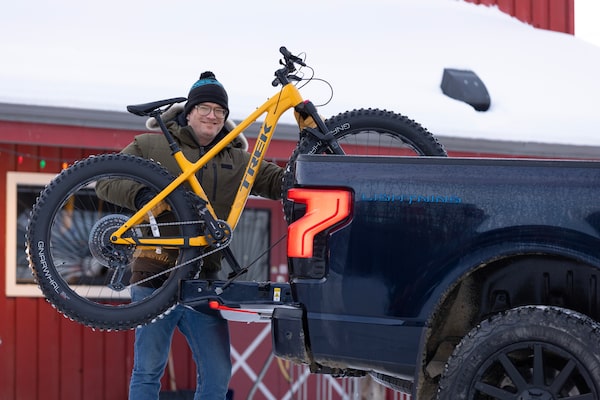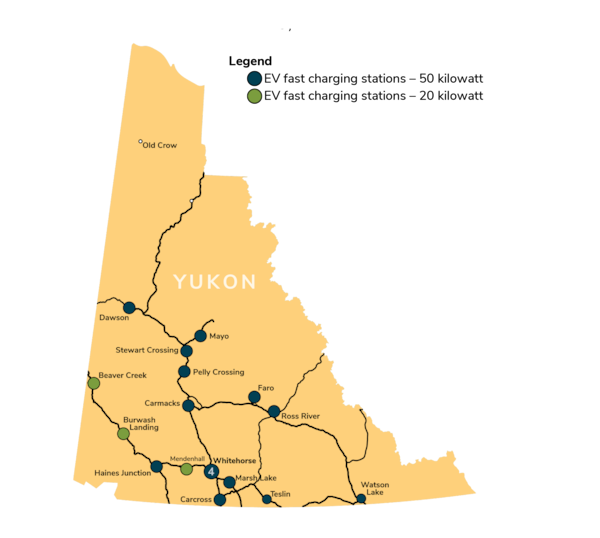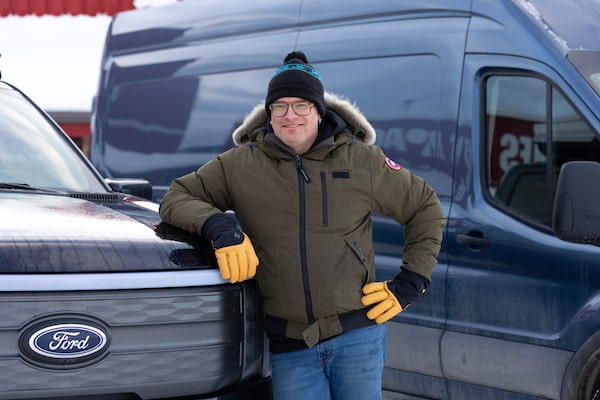
Jonah Clark loads a bike into the back of his Ford F-150 Lightning in Whitehorse on Jan. 28.Crystal Schick/The Globe and Mail
Jonah Clark was sold on electric vehicles the first time he drove one. It was 2018 and he went for a drive in a Tesla Model Y along the Alaska Highway in Yukon with someone who came into his shop. He said what he really noticed was the performance.
“Sure, there are gas vehicles with the same level of horsepower and acceleration,” he said, “but they always have that momentary lag every time they shift gears and there’s no lag with the EV.”
Clark, who owns the Icycle Sports bicycle shop in Whitehorse, went on to buy a Tesla Model Y of his own for his family, and then a Ford F-150 Lightning and a Ford E-Transit cargo van for his business.
Clark is far from an outlier in Yukon, despite freezing weather that tends to sap range and a relative lack of public charging infrastructure compared with big cities.
The region is third in Canada, behind only British Columbia and Quebec, in per capita EV ownership. In the third quarter of 2023, zero-emissions vehicles accounted for 10.4 per cent of Yukon’s new vehicle registrations.
For Clark, even though vehicle performance is important, he says his primary reason for buying EVs was environmental.
“I own a bike shop for a reason,” he said. Clark comes from an environmentalist family, has a degree in philosophy and once worked as bicycle courier in Winnipeg, riding hundreds of kilometres a week for work and racing bicycles in his free time. He is a strong believer in active transportation and sees EVs not as the only answer to the climate emergency, but as one essential piece of the solution.
Clark isn’t the only Yukoner to think about the climate.
“We’ve always had people here who care about the environment. Look at solar – we have an incredible volume of solar here. We have an environmentally conscious population, people who are keen to take action,” said Shane Andre, director of the energy branch of the Climate Change and Energy Solutions Centre for the Yukon government.
If you drive a car, “buying an EV is a huge opportunity to reduce your personal GHG [greenhouse gas] emissions,” he said.
Andre reported that in 2018-19, the Yukon government did emissions modelling to develop a new climate change strategy for the territory, including emissions reductions targets. When they looked at the data, they saw that more than half of Yukon’s greenhouse gas emissions came from transportation.
In 2020, they rolled out a territorial rebate of $5,000 for EVs that can be stacked with the federal $5,000 rebate for qualifying cars. They also started installing public chargers. They now have DC fast chargers in all road-connected Yukon communities, and several in between on the highways as well.

Yukon’s highway charging infrastructure is far ahead of many rural and remote places in Canada, including that of Northern B.C. and Northern Alberta.Handout
This puts Yukon’s highway charging infrastructure far ahead of many rural and remote places in Canada, including that of Northern B.C. and Northern Alberta.
The Yukon government also started a pilot project to incentivize electric cargo vans for the private sector. “The business community understands costs, so the cost savings on gas are persuasive,” Andre said, adding there are now 14 or 15 electric cargo vans operating at small businesses in the Yukon.
Clark has seen the cost savings first hand. He said people need to understand that while there is a higher upfront cost for an EV, the savings on gas are substantial and can offset the higher sticker price.
“The cost of financing the [Ford F-150 Lighting] truck was literally the same price as operating our diesel cargo van to Carcross [about an hour’s drive south of Whitehorse] and back every day during the summer, which is what we had been doing,” Clark said.
Once he switched to the Lightning, he estimates that he spent about $800 to charge it for an entire summer of driving mountain bike tours up Montana Mountain (about 16,000 kilometres of driving).
So, what led Yukon to be a leader in EV adoption? It seems likely that a receptive population, territorial incentives and charging infrastructure have all contributed.
Also, according to Michael Muller, vice-president of planning, environment, and health and safety at Yukon Energy, “we are a fortunate jurisdiction, in that over 90 per cent on an annual basis of Yukon Energy’s generation comes from hydro.” This means most of Yukon’s electricity comes from a renewable source, and rates are lower than in the other two territories, Nunavut and Northwest Territories.
Proponents say EVs work quite well in Yukon winters, at least for EV drivers who can charge regularly when it’s cold.
Andre makes a distinction between range loss and reliability loss in cold weather, saying cold affects range, but not reliability if a driver plans ahead and has the right setup.
“I think there is an assumption about a battery-powered vehicle in a cold climate, that there’s a reliability challenge,” he said. “You have to be aware that you’re going to lose 20 or 30 or maybe 40 per cent of your range because you’ve got to keep yourself warm and keep the battery warm, so it’s not without a cost, but I don’t feel that reliability is one of those costs.”
There is still work to be done in Yukon, though, if EV adoption is to become more widespread. With more EVs on the roads, more highway chargers will be essential. Also, as electrical loads increase, more capacity will be needed.
Muller says that Yukon Energy is looking at ways to add more renewable energy production, especially in the winter when loads are highest. He also encourages EV owners to charge their vehicles at off-peak times whenever possible to reduce their impact on Yukon’s remote electrical grid. “A Level 2 EV charger can draw as much power as an average new-build house,” Muller explained.

After buying an electric car for his family, Jonah Clark, owner of Icycle Sports, decided to buy two electric vehicles for his business.Crystal Schick/The Globe and Mail
Andre suggested that anyone who is EV curious should try driving one before deciding. “I don’t mean buy, I mean try,” he said. “Do a test drive.”
As for Clark, he said his EVs are “the best vehicles I’ve ever driven in the winter.” His EVs are parked outside year-round in Whitehorse. If it’s cold out, he preconditions or warms their batteries for a few minutes using an app, ideally while they’re still plugged in to avoid drawing down the battery. When he gets in, he said, “it’s warm and toasty, ready go to. The windows are defrosted, the interior is like 20 degrees, with heated seats, heated steering wheel.”
“I don’t even bring gloves with me sometimes,” he said, “which is not a smart thing to do even if you’re just driving around Whitehorse because, you never know, you might have to jump out and push somebody out of a snowbank.”